The history of WW1 rifles is a fascinating subject that sheds light on the powerful firearms used during this historic time period. From vintage rifles to historical firearms, these military weapons played a crucial role in the war. Let’s dive into the captivating world of WW1 rifles and uncover the stories and significance behind these iconic and collectible firearms.
Key Takeaways
- WW1 rifles were powerful firearms used in World War 1.
- These historical firearms have become collectible items and military memorabilia.
- They had a significant impact on warfare, shaping tactics and strategies.
- The legacy of WW1 rifles lives on through museum displays and private collections.
- Their influence can be seen in modern firearms technology.
The Role of Rifles in World War 1
Rifles were the mainstay of infantry soldiers during World War 1. They were used by soldiers on both sides of the conflict and played a critical role in battles and campaigns. These military weapons proved to be reliable and effective, providing soldiers with the ability to engage enemy forces from a distance. The development and use of rifles during WW1 marked a significant advancement in military firepower.
Rifles served as the primary weapon for infantry soldiers in World War 1. They provided soldiers with the means to engage enemy forces from a distance, offering both accuracy and firepower. The bolt-action design of these rifles ensured reliability and quick follow-up shots, contributing to their effectiveness on the battlefield.
The use of rifles in World War 1 transformed warfare strategies and tactics. The increased range and accuracy provided by these firearms forced armies to adapt and implement new approaches. Trench warfare became prevalent as soldiers sought cover from the deadly firepower of rifles, resulting in a new style of combat. The role of rifles in WW1 forever changed the nature of armed conflict.
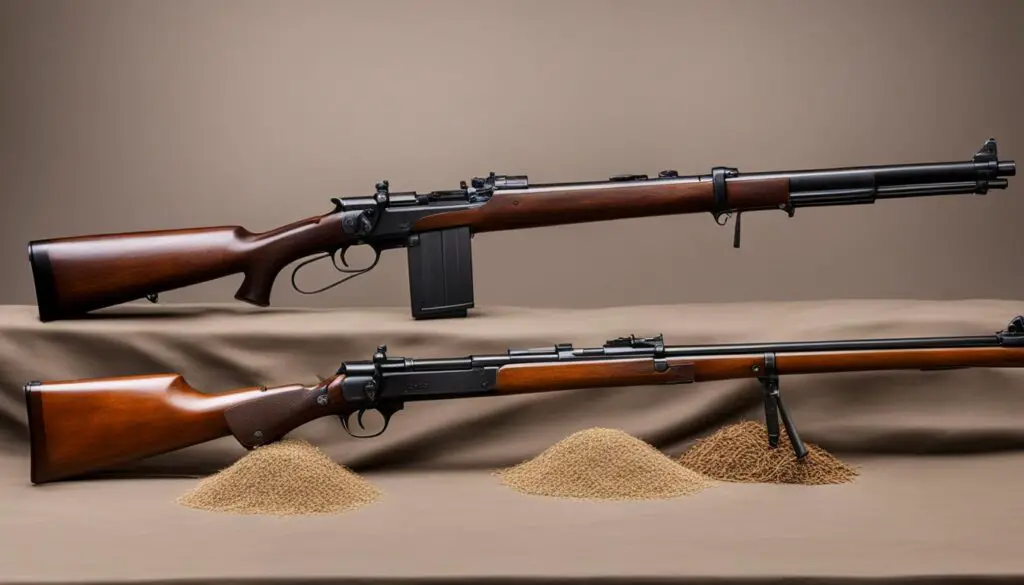
The Different Types of WW1 Rifles
During World War 1, various types of rifles were used on the battlefield. The most common and widely used type was the bolt-action rifle, which required manual operation to cycle the action and load a new round. These rifles were favored for their reliability and accuracy, making them essential military weapons for soldiers on both sides of the conflict.
Some notable examples of bolt-action rifles used in WW1 include:
- The Lee-Enfield .303 rifle, a British firearm that became the standard infantry weapon for the British Army
- The Mauser M98G 7.92mm rifle, a German rifle known for its sturdy construction and precision
- The Springfield 1903 .30–06 rifle, an American rifle that proved to be highly reliable and effective in combat
These vintage rifles from the World War 1 era have become highly sought after by collectors and enthusiasts. Their historical significance, unique design, and connection to a pivotal moment in history make them valuable and collectible items. Owning one of these collectible rifles allows individuals to own a tangible piece of history and appreciate the craftsmanship of these iconic firearms.
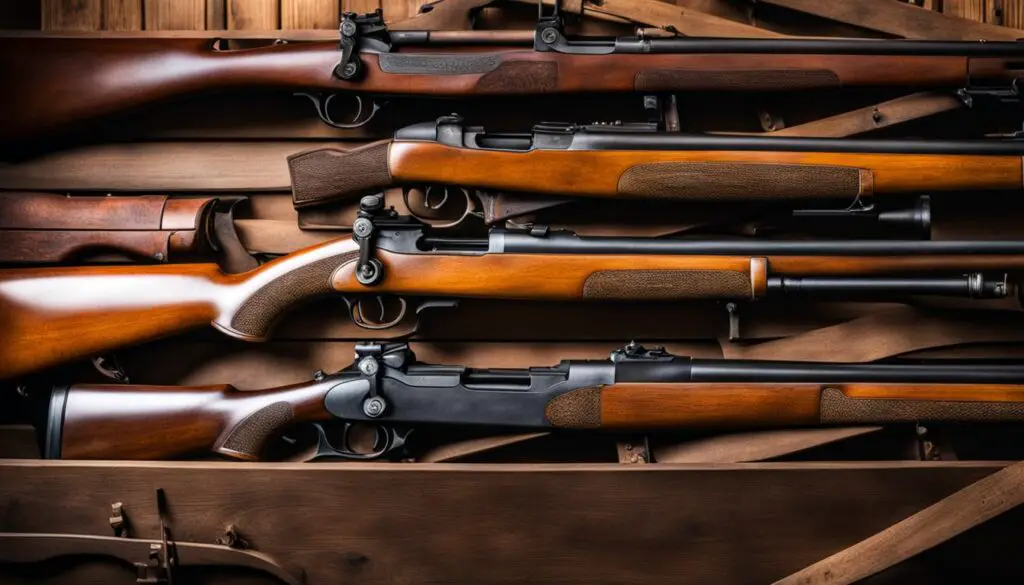
| Rifle Model | Country of Origin | Caliber |
|---|---|---|
| Lee-Enfield .303 | United Kingdom | .303 British |
| Mauser M98G 7.92mm | Germany | 7.92mm |
| Springfield 1903 .30–06 | United States | .30–06 |
Military Memorabilia: Collecting WW1 Rifles
Collecting WW1 rifles has become a popular hobby for history enthusiasts and firearm collectors alike. These antique guns and vintage rifles offer a tangible connection to the soldiers who fought in the war and serve as valuable pieces of military memorabilia. With their historical significance and unique design, WW1 rifles have captured the attention of collectors around the world.
One of the reasons why collecting WW1 rifles is so appealing is their rarity. As the years go by, these historical firearms become increasingly scarce, making them highly sought after by collectors. Each rifle tells a story of its own, with unique markings, engravings, and features that provide glimpses into the past. From the iconic Lee-Enfield .303 to the legendary Mauser M98G 7.92mm, these rifles continue to captivate collectors with their craftsmanship and historical value.
Collecting WW1 rifles allows individuals to own a piece of history and pay homage to the brave soldiers who fought during World War 1.
When it comes to collecting WW1 rifles, it’s important to do thorough research and verify the authenticity of each piece. Understanding the different models, variations, and markings is crucial in building a quality collection. Additionally, joining collector groups, attending gun shows, and connecting with experts in the field can provide valuable insights and opportunities to acquire unique rifles.
The Value of Collectible WW1 Rifles
Collectible WW1 rifles can range in value depending on factors such as rarity, condition, historical significance, and desirability among collectors. Some rifles may carry a higher price tag due to their association with famous individuals or historic events. Others may be valued for their unique variations or limited production numbers. Regardless of the specific rifle, the value lies not only in its monetary worth but also in the connection it provides to the past.
Whether you’re a seasoned collector or just starting your journey into WW1 rifle collecting, these historical firearms offer a window into an important chapter of history. By preserving and appreciating these vintage rifles, we can ensure that the sacrifices and bravery of the soldiers who wielded them are never forgotten.
Firepower of WW1 Rifles
WW1 rifles were powerful firearms that provided soldiers with significant firepower on the battlefield. These rifles had a range that allowed for accurate shooting at distances of several hundred yards. The bolt-action design ensured reliability and quick follow-up shots. The ammunition used, such as the .303 British and .30-06, packed a punch and were capable of inflicting significant damage on enemy soldiers.
To showcase the firepower of WW1 rifles, let’s take a look at a comparison between two popular rifles of the era:
| Rifle Model | Caliber | Effective Range | Rate of Fire |
|---|---|---|---|
| Lee-Enfield .303 | .303 British | 800-1,000 yards | 10-15 rounds per minute |
| Springfield 1903 .30–06 | .30-06 | 600-700 yards | 15-20 rounds per minute |
The Lee-Enfield .303, known for its reliability and versatility, had a slightly longer effective range compared to the Springfield 1903 .30–06. However, the Springfield 1903 had a slightly higher rate of fire. Both rifles were widely used by infantry soldiers during World War 1 and proved to be formidable weapons in the hands of skilled marksmen.
It’s important to note that the firepower of WW1 rifles was not just limited to their range and rate of fire. The psychological impact of these rifles on the battlefield cannot be underestimated. The thunderous sound of gunfire and the sight of enemy soldiers falling under a barrage of bullets created fear and panic, influencing the outcome of battles and campaigns.
The Evolution of Rifle Technology During WW1
The evolution of rifle technology during World War 1 brought about significant advancements in design, materials, and manufacturing processes. The demands of the war pushed for improvements in the accuracy, reliability, and production of rifles, leading to the development of more advanced firearms.
One notable advancement was the introduction of new rifle designs, such as the bolt-action rifle. This design allowed for faster and more efficient cycling of the action, enabling soldiers to fire multiple rounds quickly. The bolt-action design also improved the overall reliability of the rifles, ensuring consistent performance on the battlefield.
In addition to design improvements, the materials used in rifle manufacturing also saw advancements. The use of stronger and more durable materials, such as steel alloys, enhanced the durability and longevity of the rifles. This meant that soldiers could rely on their firearms to withstand the harsh conditions of combat without compromising functionality.
“The development of new rifle technologies during World War 1 revolutionized the way soldiers fought on the battlefield. These advancements improved accuracy, reliability, and overall performance, giving soldiers a significant advantage in combat.” – Military Historian
Furthermore, the manufacturing processes for rifles underwent changes to increase production rates. Mass production techniques were implemented to meet the high demand for firearms during the war. The adoption of standardized parts and assembly line methods streamlined the manufacturing process, allowing for quicker and more efficient production of rifles.
| Rifle Technology Advancements | Impact |
|---|---|
| Bolt-action design | Improved firing rate and reliability |
| Stronger materials | Enhanced durability and longevity |
| Mass production techniques | Increased production rates |
The evolution of rifle technology during World War 1 had a lasting impact on the development of firearms and military strategies. The lessons learned from the advancements made during this time influenced future innovations and shaped the way wars were fought in the years that followed.
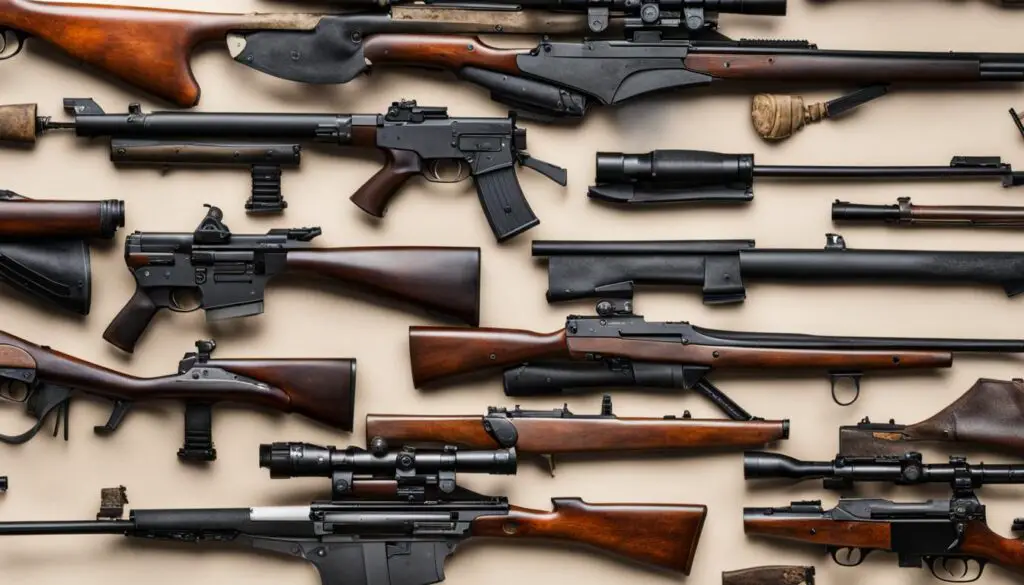
Famous WW1 Rifles and Their Stories
WW1 rifles have not only left a mark in history but have also become symbols of bravery, valor, and the sacrifices made by soldiers during the war. Among these rifles, one stands out with its intriguing story and rich pedigree.
“There are few rifles in existence that combine the history, craftsmanship, and military significance of the H&H rifle No. 26069. This classic single-shot, break-action rifle was manufactured by the prestigious Holland & Holland gunmaking firm and has a fascinating journey from the showroom to the trenches of World War 1.”
Originally showcased at the Holland & Holland showroom, this rifle made its way into the hands of a soldier who took it to the front lines. The H&H rifle No. 26069 witnessed the horrors of war and contributed to the conflict that engulfed the world during that time.
With its historical significance and connection to pre-war England, gunmaking, and military history, this rifle has become a prized piece of military memorabilia. It represents the convergence of great names and serves as a tangible reminder of the sacrifices made by soldiers during World War 1.
| Feature | Description |
|---|---|
| Manufacturer | Holland & Holland |
| Action | Single-shot, break-action |
| Caliber | .303 British |
| Provenance | Holland & Holland Showroom to the Guards Museum to the trenches of WW1 |
This rifle is just one example of the many famous WW1 rifles that have remarkable stories connected to them. Each rifle carries a unique narrative that reflects the history, courage, and perseverance of the soldiers who wielded them on the battlefield.
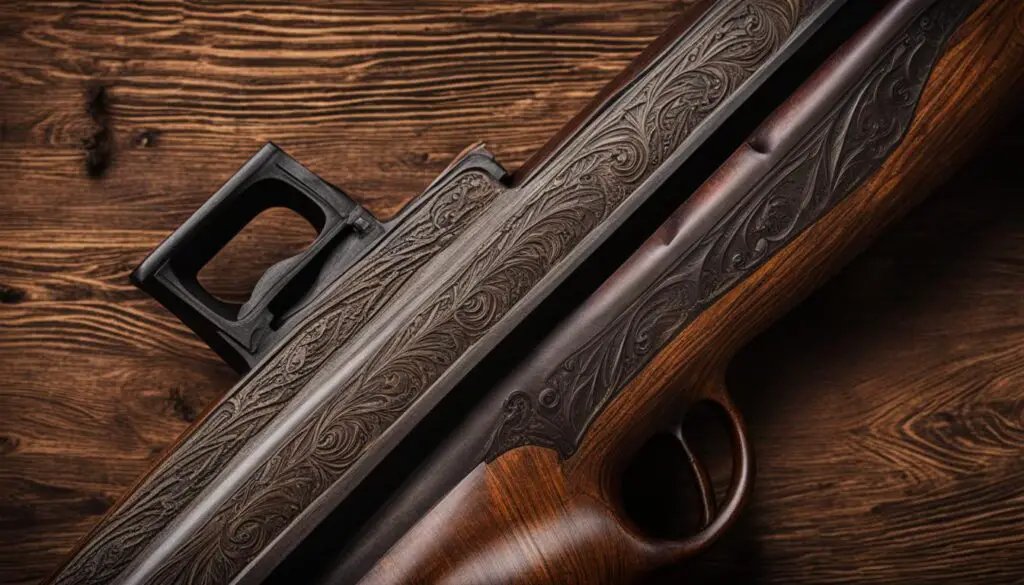
Other Famous WW1 Rifles
- The Lee-Enfield .303: A British bolt-action rifle known for its reliability and durability on the battlefield.
- The Mauser M98G 7.92mm: A German rifle renowned for its accuracy and advanced design.
- The Springfield 1903 .30–06: An American rifle that became the standard weapon for U.S. forces during WW1.
Each of these rifles has its own story to tell, adding to the rich tapestry of World War 1 and the role these historical firearms played in shaping the course of history.
The Impact of Rifles on Warfare
During World War 1, the introduction of rifles as standard infantry weapons had a profound impact on warfare. These powerful firearms revolutionized the way battles were fought and forced armies to adapt their tactics and strategies. The increased range and accuracy provided by rifles changed the dynamics of the battlefield, making it essential for soldiers to seek cover and engage in trench warfare.
The rifles used in WW1, such as the bolt-action Lee-Enfield .303 and the Mauser M98G 7.92mm, provided soldiers with deadly firepower and the ability to engage enemy forces from a distance. This shift in weaponry led to changes in the way armies were organized and the strategies employed in combat. The reliance on rifles also gave birth to new defensive tactics, such as the construction of intricate trench systems to protect soldiers from the deadly effectiveness of these military weapons.
As a result of the impact of rifles on warfare, the nature of armed conflict was forever altered. The strategic importance of infantry soldiers increased, and their role on the battlefield became more critical. The firepower provided by rifles allowed for more effective suppression of enemy forces and shaped the outcome of many battles and campaigns.
The Role of Rifles in Trench Warfare
Rifles played a vital role in the development and dominance of trench warfare during World War 1. The deadly accuracy and range of these weapons made it difficult for soldiers to engage in traditional forms of warfare. Instead, they were forced to seek cover in deep, intricate trenches dug along the front lines. Trenches became the primary method of defense, allowing soldiers to protect themselves from enemy fire while still being able to engage in combat using their rifles.
The constant threat posed by rifles led to the development of additional defensive measures, such as barbed wire entanglements, minefields, and fortifications. These measures further entrenched the soldiers and created a complex network of defensive systems that defined the warfare of the time.
Overall, the impact of rifles on warfare during World War 1 cannot be overstated. These military weapons transformed the way battles were fought, leading to the rise of trench warfare and changing the strategies employed by armies. The development and use of rifles during this time period forever shaped the future of firearms technology and influenced military strategies for years to come.
| Rifle Type | Caliber | Effective Range |
|---|---|---|
| Lee-Enfield .303 | .303 British | 800 meters |
| Mauser M98G 7.92mm | 7.92mm | 500 meters |
| Springfield 1903 .30-06 | .30-06 | 550 meters |
The Legacy of WW1 Rifles
The legacy of WW1 rifles lives on today through the interest and fascination of collectors, historians, and enthusiasts. These historical firearms serve as reminders of the sacrifices made by soldiers during the war. They are cherished as symbols of bravery and valor and are often displayed in museums and private collections. The legacy of WW1 rifles continues to captivate and inspire.
One such collector’s item is the Lee-Enfield .303, a bolt-action rifle widely used by British forces during WW1. This iconic rifle, with its distinctive design and powerful performance, represents a significant chapter in military history. Collectors and enthusiasts value the Lee-Enfield for its historical significance and craftsmanship, making it a sought-after piece in the world of vintage rifles.
Another notable WW1 rifle is the Mauser M98G 7.92mm, a German bolt-action rifle that exemplifies the technological advancements of the time. The Mauser M98G’s accuracy and reliability made it a formidable weapon on the battlefield. Today, this historical firearm is highly prized by collectors who appreciate its craftsmanship and connection to the turbulent era of WW1.
The enduring appeal of WW1 rifles lies in their status as historical artifacts that offer a tangible link to the past. These vintage rifles not only showcase the evolution of firearms technology but also tell the stories of the brave soldiers who wielded them in the trenches of World War 1. As collectors and enthusiasts continue to appreciate and preserve these historical firearms, the legacy of WW1 rifles remains alive and well.
| WW1 Rifles | Country of Origin | Notable Features |
|---|---|---|
| Lee-Enfield .303 | United Kingdom | Bolt-action, 10-round magazine |
| Mauser M98G 7.92mm | Germany | Bolt-action, five-round magazine |
The Enduring Popularity of WW1 Rifles
The enduring popularity of WW1 rifles can be attributed to their historical significance, unique design, and collectibility. Vintage rifles from this era are highly sought after by collectors who appreciate their craftsmanship and connection to the past. These antique guns have a timeless appeal that transcends generations, making them highly desirable items for enthusiasts and collectors around the world.
Collectible rifles from World War 1 hold a special place in the hearts of history buffs and gun enthusiasts alike. Their intricate designs and historical significance make them valuable additions to any collection. Whether displayed in a museum or showcased in a personal collection, these vintage rifles serve as tangible reminders of the bravery and sacrifice of soldiers who fought in the war.
The allure of antique guns extends beyond their historical value. They also offer a glimpse into the technological advancements of the time and the craftsmanship of skilled gunsmiths. Each rifle tells a story, with unique markings and features that captivate the imagination. Owning a WW1 rifle allows collectors to not only appreciate the aesthetics and mechanics of these firearms but also to connect with the past and the individuals who used them in battle.
Table: Comparison of WW1 Rifle Models
| Rifle Model | Caliber | Country of Origin | Production Years |
|---|---|---|---|
| Lee-Enfield .303 | .303 British | England | 1895-1957 |
| Mauser M98G 7.92mm | 7.92mm Mauser | Germany | 1898-1945 |
| Springfield 1903 .30–06 | .30-06 Springfield | United States | 1903-1936 |
Note: The table provides a brief comparison of some popular WW1 rifle models, including their caliber, country of origin, and production years. Please note that this is not an exhaustive list and there were many other rifle models used during World War 1.
The Influence of WW1 Rifles on Modern Firearms
The development and use of WW1 rifles had a profound influence on modern firearms technology. During World War 1, the demands of combat led to advancements in design, materials, and manufacturing processes. These innovations shaped the development of future rifles and military weapons, laying the foundation for the firearms we have today.
Advancements in Design
One of the key influences of WW1 rifles on modern firearms is the advancements in design. The bolt-action rifle, which was widely used during the war, revolutionized the way rifles were operated. Its simple and effective design paved the way for modern bolt-action rifles, known for their reliability, accuracy, and ease of use. The lessons learned from the development and use of these rifles led to improvements in ergonomics, sighting systems, and overall functionality.
Materials and Manufacturing
World War 1 also saw advancements in materials and manufacturing processes that had a lasting impact on firearm production. The need to produce rifles quickly and in large quantities led to the adoption of new manufacturing techniques, such as mass production and interchangeable parts. The use of stronger and lighter materials, such as steel and aluminum alloys, improved the durability and efficiency of firearms. These advancements in materials and manufacturing continue to shape the production of modern firearms.
Influence on Military Strategies
The use of rifles in World War 1 influenced military strategies and tactics. The increased range and accuracy provided by these firearms forced armies to adapt their approaches to warfare. Trench warfare became prevalent as soldiers sought cover from the deadly firepower of rifles. The lessons learned from the challenging conditions of WW1 shaped future military strategies, including the development of specialized infantry units and the use of combined arms tactics.
| Type of Influence | Impact |
|---|---|
| Technological Advancements | Improved design, materials, and manufacturing processes |
| Tactical Innovations | Forced armies to adapt to trench warfare and develop new strategies |
| Lessons for Future Development | Influenced the design and functionality of modern firearms |
In conclusion, the influence of WW1 rifles on modern firearms cannot be understated. The advancements in design, materials, and manufacturing, along with the impact on military strategies, shaped the development of future rifles and military weapons. Today, we continue to see the impact of these historical firearms in the design and functionality of modern firearms. The stories and significance of WW1 rifles carry on, reminding us of the technological advancements and sacrifices made during the war.
Conclusion
In conclusion, WW1 rifles played a pivotal role in the history of warfare. These historical firearms, with their powerful firepower and advanced design, shaped the outcome of World War 1 and left a lasting impact on military strategies. The legacy of these rifles lives on through the interest and fascination of collectors and enthusiasts, who appreciate their historical significance and craftsmanship.
Today, WW1 rifles are highly sought after as collectible items and military memorabilia. Their rarity and unique features make them valuable pieces of history, cherished by those who recognize their role in the bravery and valor displayed by soldiers during the war. These historical firearms continue to be displayed in museums and private collections, ensuring that their stories and significance are remembered for generations to come.
The influence of WW1 rifles extends beyond their historical context. The innovations and advancements seen in these firearms shaped the development of modern rifles and military weapons. Lessons learned from their design and performance continue to impact the technology used in today’s firearms, highlighting their enduring legacy in the field of weaponry.
FAQ
What types of rifles were used during World War 1?
The most common type of rifle used during WW1 was the bolt-action rifle, including the Lee-Enfield .303, the Mauser M98G 7.92mm, and the Springfield 1903 .30–06.
Why are WW1 rifles highly valued as collectible items?
The historical significance and rarity of these antique guns make them sought after by collectors and history enthusiasts.
How powerful were WW1 rifles?
WW1 rifles had a range that allowed for accurate shooting at distances of several hundred yards, and the ammunition used packed a punch and were capable of inflicting significant damage on enemy soldiers.
How did WW1 rifles impact warfare?
The increased range and accuracy provided by rifles forced armies to adapt their tactics and strategies, leading to the dominance of trench warfare.
What is the legacy of WW1 rifles?
The legacy of WW1 rifles lives on through the interest and fascination of collectors, historians, and enthusiasts, serving as reminders of the sacrifices made by soldiers during the war.
Why are vintage WW1 rifles highly sought after by collectors?
Vintage rifles from this era are highly valued for their craftsmanship and connection to the past, making them desirable items for enthusiasts and collectors around the world.
How did the development of WW1 rifles influence modern firearms?
The design and performance of these historical firearms shaped the development of future rifles and military weapons, leading to advancements in design, materials, and manufacturing processes.
Source Links
- https://www.americanrifleman.org/content/a-gentleman-s-rifle-in-the-trenches-of-wwi/
- https://www.americanrifleman.org/content/forgotten-u-s-infantry-rifles-of-world-war-i/
- https://www.historynet.com/weapons-of-world-war-i/
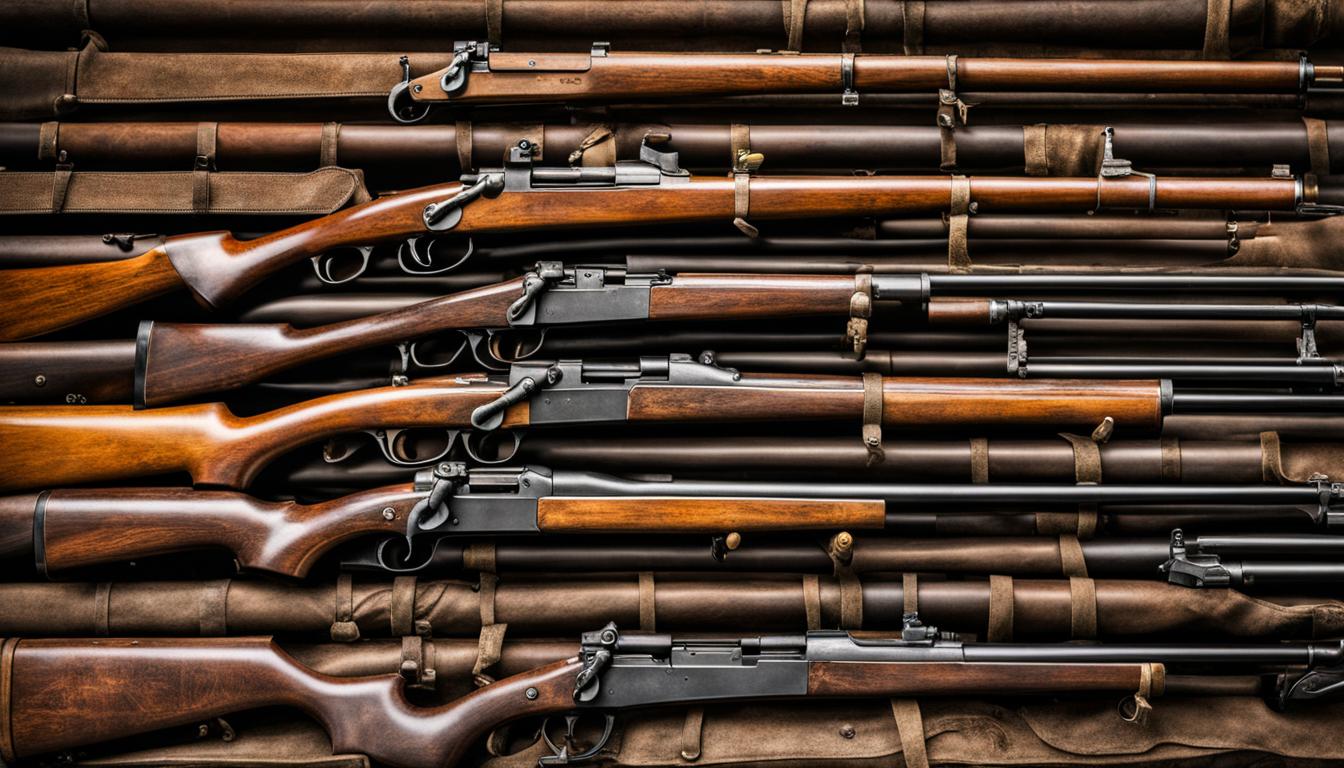

[…] Civil War battles offers valuable insights into this pivotal period of American […]